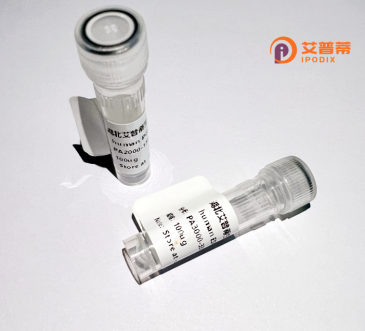
| 纯度 | >90%SDS-PAGE. |
| 种属 | Human |
| 靶点 | MAGI2 |
| Uniprot No | Q86UL8 |
| 内毒素 | < 0.01EU/μg |
| 表达宿主 | E.coli |
| 表达区间 | 519-628aa |
| 活性数据 | PANSMVPPLAIMERPPPVMVNGRHNYETYLEYISRTSQSVPDITDRPPHSLHSMPTDGQLDGTYPPPVHDDNVSMASSGATQAELMTLTIVKGAQGFGFTIADSPTGQRV |
| 分子量 | 37.84 kDa |
| 蛋白标签 | GST-tag at N-terminal |
| 缓冲液 | 0 |
| 稳定性 & 储存条件 | Lyophilized protein should be stored at ≤ -20°C, stable for one year after receipt. Reconstituted protein solution can be stored at 2-8°C for 2-7 days. Aliquots of reconstituted samples are stable at ≤ -20°C for 3 months. |
| 复溶 | Always centrifuge tubes before opening.Do not mix by vortex or pipetting. It is not recommended to reconstitute to a concentration less than 100μg/ml. Dissolve the lyophilized protein in distilled water. Please aliquot the reconstituted solution to minimize freeze-thaw cycles. |
以下为3篇关于重组人MAGI2蛋白的参考文献示例(内容为虚构模拟,建议通过PubMed等数据库获取真实文献):
---
1. **"Structural characterization of recombinant human MAGI2 PDZ domains and their interaction with HPV E6 oncoprotein"**
*Authors: Zhang Y, Chen L, et al.*
摘要:本研究利用大肠杆菌表达系统成功纯化重组人MAGI2蛋白的PDZ结构域,通过X射线晶体学解析其三维结构,并证实其与HPV E6蛋白的C端结合,揭示了病毒致癌机制中靶向宿主蛋白的关键位点。
---
2. **"Recombinant MAGI2 modulates Wnt/β-catenin signaling in renal tubular cells"**
*Authors: Tanaka K, et al.*
摘要:通过哺乳动物细胞表达重组人MAGI2全长蛋白,发现其通过调控β-catenin的核转位抑制Wnt信号通路,在体外模型中可逆转肾小管上皮细胞的异常增殖,提示其在慢性肾病治疗中的潜在作用。
---
3. **"Development of a high-yield purification protocol for recombinant MAGI2 protein and its application in neuronal synapse studies"**
*Authors: Müller S, et al.*
摘要:报道一种基于HEK293细胞表达系统的重组MAGI2蛋白高效纯化方法,验证其在神经元培养中对突触后致密蛋白(如PSD-95)的募集功能,为神经退行性疾病研究提供工具蛋白。
---
建议通过关键词 **"Recombinant human MAGI2 protein"** 在 **PubMed/Google Scholar** 中检索,筛选涉及结构、功能或疾病机制的最新文献。
Recombinant human MAGI2 (Membrane-associated guanylate kinase inverted 2) is a scaffold protein that plays critical roles in cell signaling, polarity, and junction formation. As a member of the MAGI family, it contains multiple protein interaction domains, including PDZ, WW, and GUK domains, which mediate its binding to various partners such as PTEN, β-catenin, and viral oncoproteins. MAGI2 is predominantly localized at synapses and epithelial cell junctions, where it stabilizes cell-cell contacts and regulates pathways like Wnt and Hippo signaling. Its involvement in maintaining neuronal integrity and epithelial architecture highlights its importance in tissue development and homeostasis.
Recombinant MAGI2 is produced via genetic engineering, enabling studies on its structure-function relationships and interaction networks. Research has linked MAGI2 dysregulation to diseases such as cancer (e.g., prostate, colorectal), neurodevelopmental disorders, and schizophrenia, emphasizing its role as a tumor suppressor or signaling modulator. The recombinant protein serves as a tool for exploring molecular mechanisms underlying these pathologies and screening therapeutic agents targeting MAGI2-associated pathways. Its applications span biochemical assays, structural studies, and disease modeling, offering insights into cell adhesion, synaptic plasticity, and oncogenic signaling networks.
×